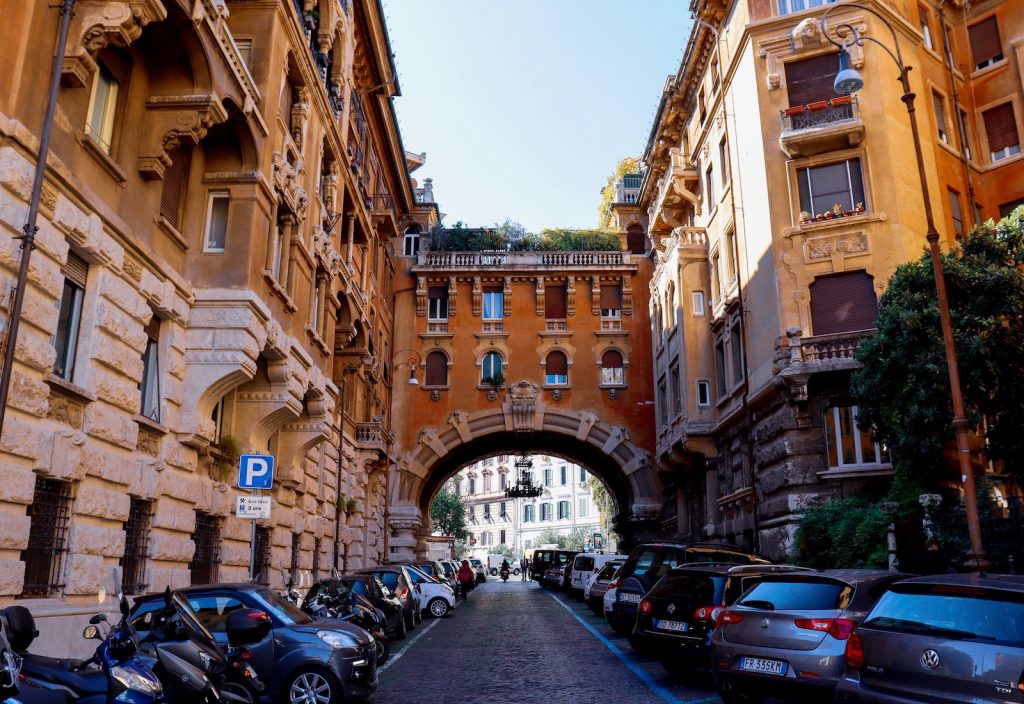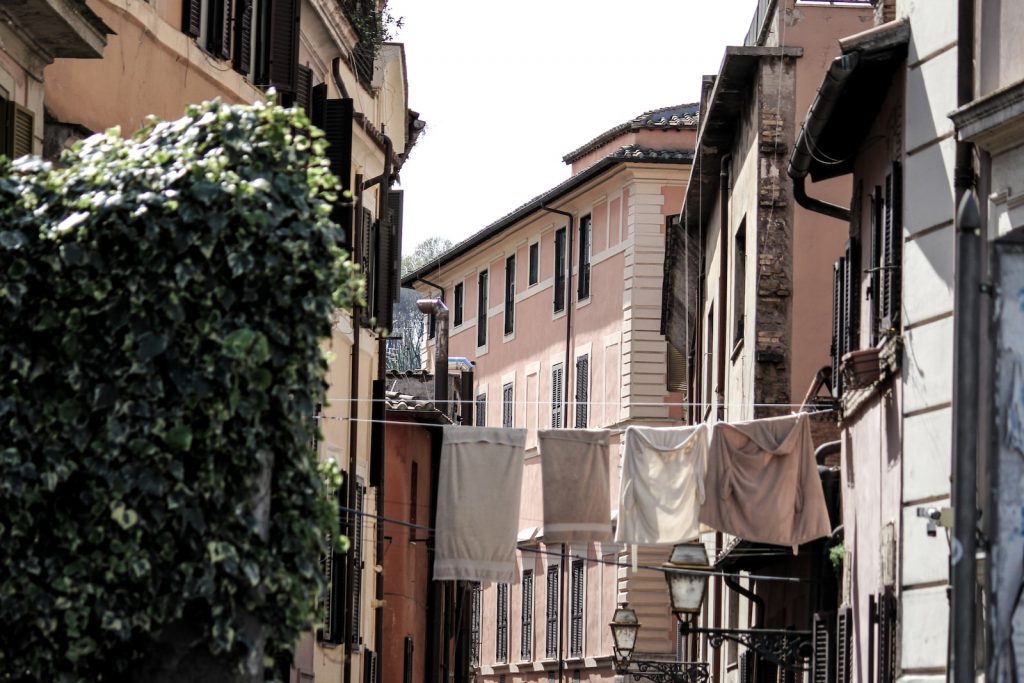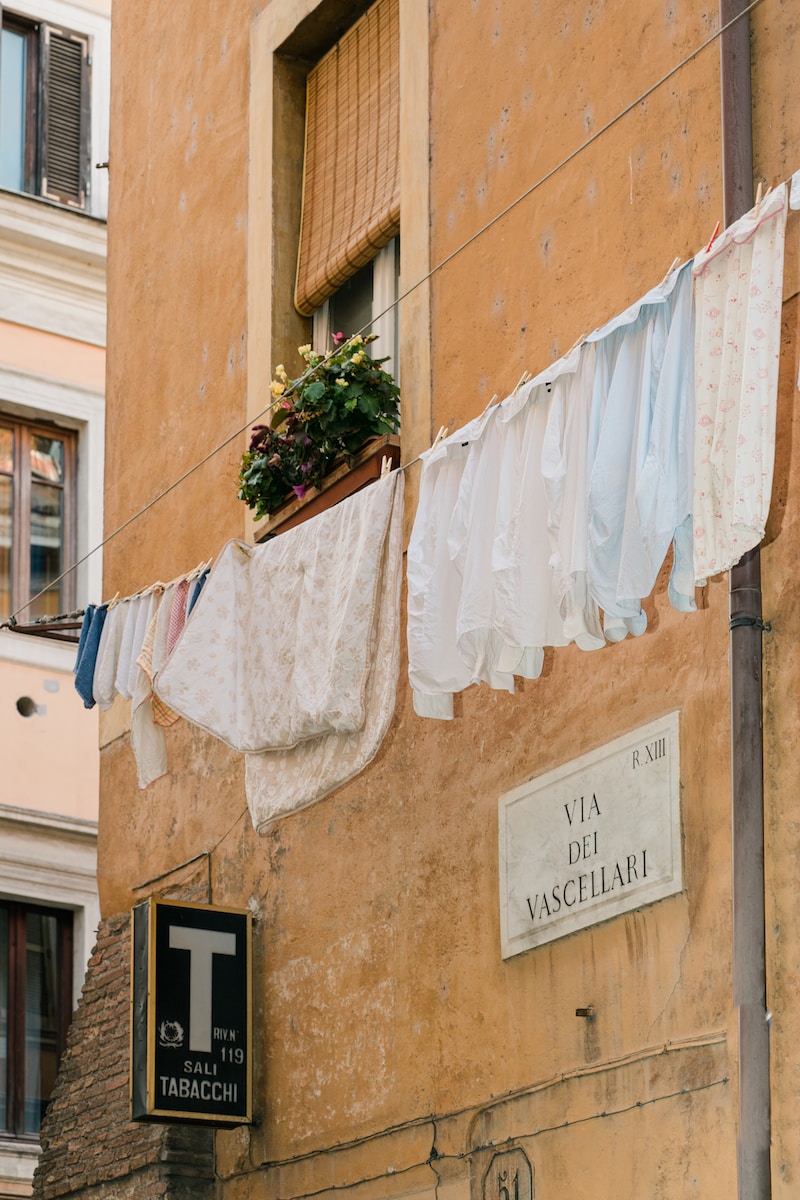As a travel advisor who lived in Rome for almost 2 years, I’m often asked for recommendations on places to visit beyond the usual tourist traps. While no trip to Rome is complete without seeing the Colosseum, the Trevi Fountain, or the Spanish Steps, there are so many hidden gems waiting to be explored by those looking to get off the beaten path. Here are some of my favorite lesser-known attractions, ancient sites, outdoor spaces, churches, museums, and day trips that will give you a more local experience of the Eternal City.
Quartiere Coppedè: An Architectural Wonder in Rome

Tucked away behind Piazza del Popolo lies the Quartiere Coppedè, a uniquely eccentric residential neighborhood practically unknown to visitors. Built between 1913 and 1926, Coppedè features a mix of Art Nouveau, Gothic, Greek, Baroque, and Medieval architecture blended together in a surreal fashion. The curved archways, turrets, stone motifs of frogs and snails, and fairy-tale details make it seem like something out of a storybook. Make sure to see the Fontana delle Rane (Fountain of the Frogs) depicting four frog statues spitting water and the Villino delle Fate (House of Fairies) covered in mystical symbols. Wandering through the whimsical streets of Coppedè feels transportive, an oasis of wonder away from Rome’s grandeur and crowds.
Basilica di Santo Stefano Rotondo al Celio: A Lesser-Known Basilica with a Grisly Past

The circular Basilica di Santo Stefano Rotondo lies tucked away on the peaceful Celian Hill, but its tranquil appearance belies its grisly history. Founded in the 5th century on the site of several martyrdoms, the walls of the basilica feature realistic paintings of famous Christian martyrs being horrifically tortured and killed in ancient Rome. The almost macabre artwork is starkly contrasted by the bright sunlight filtering through the oculus in the domed ceiling. An eerie yet awe-inspiring spot, Santo Stefano Rotondo provides a sobering look into Rome’s brutal past amidst an oasis of solitude off the beaten path.
Trastevere: Rome’s Beloved Medieval Neighborhood

With its cobblestone streets lined with ivy-covered buildings glowing golden in the sunset, Trastevere offers visitors a glimpse into medieval Rome. Located just across the Tiber River, this charming district has historically been home to the working class. Explore the neighborhood to find trendy boutiques and artisan shops, wine bars bursting with locals and expats, and some of Rome’s best restaurants serving up classic Roman cuisine. Don’t miss the gorgeous Santa Maria in Trastevere basilica, illuminated by glimmering golden mosaics at night. Grab a gelato and join the locals on the steps of the fountain in Piazza di Santa Maria to soak up Rome’s most quintessential neighborhood.
The Knights of Malta Keyhole: A Tiny Peephole into Rome’s Past

At the top of Aventine Hill lies one of Rome’s most curious hidden attractions – the Knights of Malta keyhole. The unmarked green door at the Priory of the Knights of Malta belongs to the embassy of the sovereign state, and the only publicly accessible part is the keyhole itself. Bend down and peek through this tiny hole to see the perfect optical illusion: a direct view along a tree-lined path through three countries to St. Peter’s Basilica dome in the distance. This unexpected and clever vantage point packs centuries of history into a tiny peephole, allowing you to metaphorically peer back through the epochs of time in Rome all at once.
Via Margutta: Rome’s Artsy Hidden Street

Tucked away between Piazza del Popolo and the Spanish Steps lies Via Margutta, a quaint cobblestone street that serves as an open-air art gallery showcasing sculpture exhibits year round. Historically home to impoverished artists and today filled with independent art galleries, this small street in the Campo Marzio neighborhood oozes bohemian charm. Famed residents have included film director Federico Fellini, painter Pablo Picasso and playwright Tennessee Williams. See if you can spot the small alley by Picasso’s former studio filled with children’s drawings decorating the walls, lovingly called Vicolo dei Catinari (Alley of the Kitten Catchers). Spend an afternoon wandering slowly down Via Margutta admiring artwork old and new in this hidden creative haven.
Doria Pamphilj Gallery: Rome’s Best Private Art Collection

Housed in a grand palazzo near the Trevi Fountain, the Doria Pamphilj Gallery contains Rome’s largest private art collection, with works spanning from the Renaissance to the 18th century. The Pamphilj nobility, one of the most powerful Roman families for centuries, started their opulent art collection in the 1640s. Wander the lavishly decorated rooms and galleries to discover amazing pieces by Velazquez, Caravaggio, Titian, Raphael, and more with relatively few crowds. Don’t miss the famous Velazquez portrait of Pope Innocent X, rumored to be haunted by the family. With over 700 works to admire, the Doria Pamphilj Gallery lets visitors step back in time and live among Rome’s ultra-elite for an afternoon.
Capuchin Crypts: Exploring Rome’s Macabre Past

Beneath the church of Santa Maria della Concezione lies perhaps the eeriest site in Rome – the Capuchin crypts. Created in the 17th century from thousands of Capuchin friar bones, this series of crypts holds the skeletons of over 3,700 friars artfully arranged into elaborate ceiling designs, swirls, patterns and even a full skeleton chandelier. Exploring the macabre crypts provides a perspective into past Roman attitudes on death vastly different from today, as well as insight into traditions of the Capuchin order. The unusual and somewhat unsettling museum offers visitors a darker historical lens not featured in most tours of baroque churches or ancient ruins. Prepare to come face to face with centuries of deceased as you examine each crypt up close.
Largo di Torre Argentina: More Than Just Ruins

Most people wandering through Largo di Torre Argentina in central Rome simply admire the excavated Republican-era ruins and Temple of Juturna dating back to the 4th century BC. But unknown to many visitors, the ruins double as the oldest cat sanctuary in Europe, with a no-kill shelter occupying the empty spaces underneath. Today some 140 formerly abandoned cats call the Largo di Torre Argentina home, cared for by a team of volunteers. Cat lovers visiting the archaeological site should come bearing cat treats or donations for Gattare senza Frontiere, and will likely make some furry friends wandering through the temple columns.
Vatican Necropolis: Exploring St. Peter’s Ancient Burial Site

Directly underneath St. Peter’s Basilica lies a dark labyrinth of ancient pagan mausoleums and shrines hidden from public view for centuries – the Vatican Necropolis. Also called the Scavi Tour, visiting these excavated ruins 20 meters below allows a literal walk through the centuries, starting with St. Peter’s own tomb. In the dim candlelight, you can gaze upon elaborately frescoed tombs from Roman nobility converted to Christian shrines and chapels over time. Wandering past tightly packed mausoleums while learning about burial customs of ancient Romans culminates with the surprisingly modest resting place of St. Peter himself, marked by a simple engraved marble slab. Booking the hard-to-get Scavi Tour takes you on a spine-tingling journey through the physical layers of Rome’s rich history.
Appian Way: More Than Just Ancient Ruins

Most visitors exploring the Appian Way focus only on the ancient paving stones and crumbled ruins along the 7-mile ancient Roman road leading south out of Rome. But the area offers more beyond the tourist-centric stretch between the Baths of Caracalla and the Tomb of Cecilia Metella. Venture farther south to discover a more peaceful atmosphere surrounded by Roman aqueducts slicing through vineyards and farms. Enjoy a meal of classic pasta all’amatriciana at quiet country restaurants around the charming town of Frattocchie. As the road winds past the catacombs of San Callisto and Domitilla, you’ll gain perspective into everyday life of past citizens all but forgotten to history. Wandering the Appian Way provides a scenic escape into the Roman countryside.
Catacombs of St. Callixtus: Rome’s First Official Cemetery

The Catacombs of St Callixtus, the first official cemetery of the Christian church founded in the 2nd century AD, represent the world’s oldest extant papal burial ground. Descending into the dim hypogeum, visitors can explore the ornate crypts and chapels where nine 3rd century popes were entombed. Get a glimpse into Rome’s early transition to Christianity while admiring frescoes depicting bible scenes, ceiling decorations, and stone epigraphs etched by early Christians. The catacombs contain over 500 tombs sprawling over 15 kilometers. Much smaller than some of Rome’s other catacomb networks, St. Callixtus offers an more intimate look at ancient Christian customs, history and art.
Chiesa Santa Maria Addolorata: A Hidden Church Honoring Jesus’ Passion

Tucked away in a residential corner of Rome, Chiesa Santa Maria Addolorata is one of the city’s most curious hidden churches. With a plain brick exterior, you would never expect a lavishly decorated sanctuary inside honoring the Passion of Christ, built between 1842-1860. Every surface glitters with intricately patterned multicolored marble, gilt sculptures depict the Stations of the Cross along the aisles, and an ornately carved altar gleams beneath a 19th century crucifix studded with gemstones said to be from the imperial crown of thorns. While relatively unknown compared to grandeur of St. Peter’s Basilica, Santa Maria Addolorata provides a tranquil, glittering refuge where visitors can reflect on Jesus’ suffering away from the crowds.
Janiculum Hill: The Best Views in Rome Reached on Foot

Many visitors snap selfies in front of the colorful Fontana dell’Acqua Paola on Janiculum Hill then swiftly depart, unaware a grand staircase leads up to the piazzale Giuseppe Garibaldi with perhaps the best panoramic views across Rome. Make the climb up the steep stairway through fragrant, lush vegetation to discover a towering monument to Garibaldi along with one of the eternals city’s most jaw-dropping vistas. From the Gianicolo viewpoint on a clear day, all of Rome unfolds below you from the dome of St. Peter’s on the left to the ruins of the Palatine on the right, with the Tiber River and countless monuments plus neighborhoods in between. Arrive near sunset on a weekend evening to watch locals flying kites before the sky explodes in a pastel watercolor backdrop.
Park of the Aqueducts: Rome’s Monumental Ruins Turned Park

While most visitors flock to the famous Colosseum, Rome contains many marvelous ruins worth exploring. The Parco degli Acquedotti, or Park of the Aqueducts, allows you to take a peaceful stroll right through the imposing remains of 11 ancient Roman aqueducts, including the towering Aqua Claudia begun in 38 AD. The park’s casual trails and grassy fields offer the perfect picnic spot amidst crumbling ruins now alive with lush greenery. People commonly bike, jog or walk dogs along the Appian Way stretch bordering the park. One of the city’s quintessential Roman landscape views photographers love capturing is here too – the Aqua Claudia aqueduct framing a contemporary apartment building in the background. Getting lost amidst the mammoth brick and stone arches remind you of Rome’s former powerful empire.
Domus Aurea – Nero’s Golden Palace Underground

The notorious Roman emperor Nero thoroughly overindulged on personal extravagances, with none so decadent as his fabled Domus Aurea, or Golden Palace. After the Great Fire of 64 AD allowed him to seize private land for personal use, he built a lavishly landscaped palace complex complete with a lake, game preserves and vineyards – along with golden decorations on every surface that lent the villa its name. Below today’s bustling modern streets, you can tour the underground ruins including the unique octagonal room, intricate stucco carvings and elaborate frescoes. Wandering through the cavernous rooms and halls provides fascinating insight into the megalomaniacal lengths dictators will go to satiate their egos.
Galleria Sciarra: Rome’s Secret Art Nouveau Courtyard

Hidden behind an inconspicuous doorway in central Rome lies the Galleria Sciarra, a spectacular 19th-century glass-covered courtyard bursting with gilded Art Nouveau opulence few tourists discover. Built in 1888 within a former monastery, this trapezoidal-shaped galleria features decoration inspired by scenes from the Divine Comedy crafted by sculptor Giulio Monteverde. Admire the central figure of a muscular Dante gazing at ethereal golden sculptures and frescoes filled with allegorical figures from 18th century poems as spears of sunlight pierce the colored glass ceiling panels. This hidden jewel box of Italian decor visual arts provides a glimpse into Rome’s 19th century fascination with Dante’s epic poem away from the throngs of sightseers.
Baths of Caracalla: Massive 3rd Century Roman Bath Ruins

Constructed between 212-216 AD to accommodate 1,600 bathers at once, the 10-acre Baths of Caracalla represent some of Rome’s most impressive ancient ruins. The three-story remains allow you to wander through the extensive tunnels, structures and mosaic fragments to comprehend the sheer epic scale while picturing the various pools, gyms, libraries, and garden courtyards that once stood. Today the ruins host the summer opera festival with performances under the stars. The baths remind visitors that in ancient Rome, bathing played a central social ritual where citizens across class lines communed and connected while going about quotidien hygiene. Walking through the fallen columns and giant brick walls captures your imagination about what grandiose engineering feats the Romans achieved.
Villa Borghese Gardens: Sculptures and Green Space in the Heart of Rome

Stretching across the northern part of Rome sits the vast Villa Borghese gardens originally founded as a private vineyard by the noble Borghese family in the early 1600s. Today this sprawling central park offers leafy trails perfect for strolling, along with museums, fountains, and eye-catching sculptures like Canova’s Pauline Bonaparte. Rent a bike or Segway to explore grounds dotted with temples, villas and even a replica of Shakespeare’s Globe Theatre. Do as the locals do and relax sprawled across the grass or terrace of Caffè del Lago overlooking the lake lined with monumental statues of illustrious Italians like Galileo. With over 70 acres of English-style gardens intermixed with galleries and historic buildings, you can easily spend an entire day enjoying Villa Borghese’s beauty and tranquility.
St. Clement Basilica: Legendary Site of a Roman Pope’s Home

According to ancient legend, after the apostle Peter ordained Clement the third Pope, he was sent into exile from Rome where he converted hundreds to Christianity. Before his martyrdom in Crimea, Clement supposedly built a church next to his family home to celebrate the Eucharist in secret. Today the Basilica di San Clemente stands over a literal layered cake of historical eras – a 12th century basilica built atop a 4th century church with foundations resting on a 1st century Roman temple and even older insula ruins. Descend the stairs to journey back through centuries wandering the dimly-lit remains of multiple periods fused together, including colorful Renaissance frescoes and an eerie undercroft allegedly used for pagan sacrifices. This multi-tiered church provides an actual walk back through many chapters of Rome’s extensive history all in one place.
Isola Tiberina: The Mythical Island in the Tiber River

According to legend, the boat carrying a huge snake god statue ran aground in the river here, prompting the Romans to erect a temple to the healing deity Aesculapius on this tiny Tiber River islet. Through plague, floods, and sackings, Isola Tiberina endures as one of Rome’s most symbolic spots steeped in mythic aura. Cross the picturesque Ponte Fabricio footbridge to explore the mysterious island, home to one of the oldest hospitals in the world, the ancient San Bartolomeo all’Isola basilica, and a large marble obelisk. Especially atmospheric at night when passing river lights reflect in shimmering gold ripples, this wee island exudes cozy, magical charm. Grab a gelato and sit beside the river, staring at Isola Tiberina’s church tower set against the Trastevere neighborhood horizon, conjuring images of millenia past.
